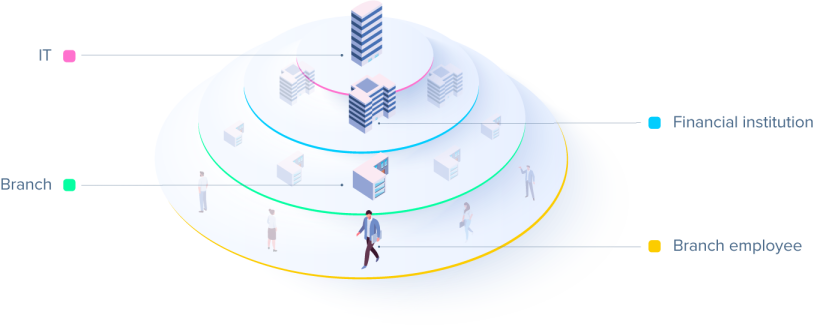Features
Discover the full benefits of MOCA365

Self-service portal
MOCA365 comes with a customisable premade SharePoint communication site. From the self-service portal it is possible for end users to request and create workspaces that supports their needs.
Using the self-service portal makes it easier to answer the question: “Which tool when?” by only presenting the relevant options to the end user.

Integrated adoption
The self-service portal has integrated adoption material. It comes with a set of premade information, texts and videos which can be adjusted to your organisation.
It is easy to configure the creation wizards and guide the users safely through the process. User friendly e-mail notifications are predefined with best-practice adoption material.

Rich email notifications
MOCA365 delivers a variety of different email notifications. Most governance tasks have a corresponding email notification. All notifications can be customised without code.
Examples of notifications: “New workspace is created”, “Owners are missing”, “A revision is needed”, “A guest user is added”, and more.

Rich templating functionality
An out-of-the-box set of templates are part of the self-service portal. This makes it possible to start the solution without too much configuration. It is possible to modify the existing templates, delete them, and create new ones.
Examples of templates: Team settings, metadata for search refinement, auto-populate SharePoint site contents, predefinned tabs, predefined channels, document templates, ad-hoc workspace, organisational workspace, project workspace, and more.

Built in governance and life cycle management
- Detect new groups
- Detect deleted and archived groups
- Ensure owners (detects and ensures that there are two owners for all M365 groups)
- Guest-user-added detected
- Time-for-review detection
- Main governance job (which checks properties on Teams and SharePoint to notify if there has been any changes).

Metadata on workspaces
It is possible to configure metadata on workspaces. A typical way to use this functionality is to define metadata for certain types of workspaces and require the user to fill in the metadata when they request a new workspace.
A simple example is a workspace designed for customer projects. Metadata that could be requested as part of the creation process could be the project name, project description, or customer name.

Support for roles
MOCA365 supports different roles which can be managed in Azure AD.
This makes it possible to have roles with administrative privileges and to limit which workspaces should be visible for end users.

Configurable web parts
MOCA365 comes with two highly configurable web parts. For simple and normal scenarios, the web parts are predefined and do not have to be configured.
However, the web parts make it possible to support more complicated scenarios like bespoke user interface (forms), and bespoke listing of workspaces without making code changes.

AD synchronised teams
We often encounter organisations that for one reason or another cannot use dynamic groups but still want the membership of the M365 group to be managed by existing security or distribution groups.
In this scenario, the AD synchronised teams is very useful.

Monitor and enforce settings
It is possible for IT to configure which settings should be monitored and/or enforced. This can be done at either the tenant or workspace level.
Settings that need to be enforced can be enforced at creation time or at a later stage.

Admin interface
From the admin interface, it is possible to modify metadata and ownership of the groups.



“We call MOCA365 the Provisioning Engine because it enables provisioning exactly as we want it. At the same time, we have created the framework for a solution which has shown – even after the implementation – easy to adapt and develop upon. MOCA365 has truly provided us with what we needed.”
Advanced features
API-First – Prepared for integrations
Multi-tenancy features
All the features that are available in MOCA365 can also be used in a multi-tenant setup. This is highly relevant if:
- You are a Microsoft Partner that have multiple customers, and you want to be able to distribute MOCA365 in combinations with your own SharePoint solutions in an easy way.
- You are a large organization with multiple Microsoft 365 Tenants. In this case the templates you defined can be re-used across Tenants. MOCA365 can also be used to configure and synchronize Term Stores, Content Type Hubs, and Search Schema.
- You work with SharePoint in a structured way. A lot of artifacts in SharePoint lives at tenant level. When possible we recommend our customers to have staging environments and verify changes before, they are made to production. However, it is often difficult to do this by hand. MOCA365 can be used to move configurations made in DEV or TEST environments, to Production and thereby support lifecycle management for Content Types and Search Schema.
Multiple MOCA365 instances in one tenant
It is possible to have multiple instances of MOCA365 in one tenant (decentralized administration and governance). This feature allows larger organizations to distribute governance without granting part of the organization with administrative privileges.
A sample of this could be a large international organization, that has multiple business units located outside of HQ.
HQ could be located in Denmark, and one of the business units could be located in Sweden. It is possible for HQ / Corp IT to create an instance of MOCA365 to the Swedish business unit, while defining a role that grants admin access to all workspaces that belongs to that business unit. This will allow Sweden (local IT) to manage their workspaces without having access to the whole tenant.

Supporting 3rd Party Solutions
MOCA 365 can be extended with own custom solutions (Power Platform, SharePoint and Teams solutions), so that MOCA365 can be used to distribute SPFx solutions among other things.
Power BI Dashboards
All data collected by the MOCA365 is stored in a SQL Database ready for report generation. This makes it possible to create your own Power BI dashboards.
An advanced usage of this feature is to collect properties from M365 groups, sites, webs, teams and channels. All properties in the object model can be collected without requiring administrators to write powershell.
A sample usecase for this is to let the MOCA365 tool collect usagedata for SharePoint and Teams and store that in the Database and make reports based on this information. It could also collect which sites have guest users.

MOCA365 Insights
Directly to your inbox
Learn how MOCA365 complements and enables Microsoft 365 standard functionality – without altering the platform.
Sign up to receive communications for upcoming events, webinars, news, and insights from Pointwork A/S.


